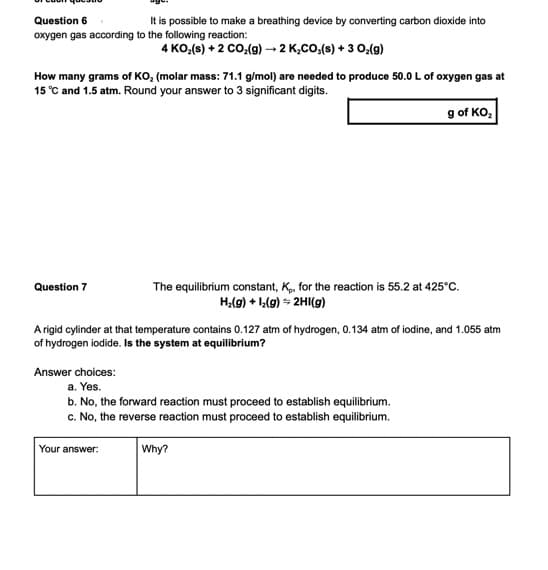Question 6 oxygen gas according to the following reaction: It is possible to make a breathing device by converting carbon dioxide into 4 KO,(s) + 2 Co,(9) 2 K,Co,(s) + 3 0,(g) How many grams of KO, (molar mass: 71.1 g/mol) are needed to produce 50.0 L of oxygen gas at 15 °C and 1.5 atm. Round your answer to 3 significant digits.
Question 6 oxygen gas according to the following reaction: It is possible to make a breathing device by converting carbon dioxide into 4 KO,(s) + 2 Co,(9) 2 K,Co,(s) + 3 0,(g) How many grams of KO, (molar mass: 71.1 g/mol) are needed to produce 50.0 L of oxygen gas at 15 °C and 1.5 atm. Round your answer to 3 significant digits.
General Chemistry - Standalone book (MindTap Course List)
11th Edition
ISBN:9781305580343
Author:Steven D. Gammon, Ebbing, Darrell Ebbing, Steven D., Darrell; Gammon, Darrell Ebbing; Steven D. Gammon, Darrell D.; Gammon, Ebbing; Steven D. Gammon; Darrell
Publisher:Steven D. Gammon, Ebbing, Darrell Ebbing, Steven D., Darrell; Gammon, Darrell Ebbing; Steven D. Gammon, Darrell D.; Gammon, Ebbing; Steven D. Gammon; Darrell
Chapter5: The Gaseous State
Section: Chapter Questions
Problem 5.118QP: Raoul Pictet, the Swiss physicist who first liquefied oxygen, attempted to liquefy hydrogen. He...
Related questions
Question

Transcribed Image Text:Question 6
It is possible to make a breathing device by converting carbon dioxide into
oxygen gas according to the following reaction:
4 KO,(s) + 2 co:(g) → 2 K,CO,(s) + 3 0,(g)
How many grams of KO, (molar mass: 71.1 g/mol) are needed to produce 50.0 L of oxygen gas at
15 °C and 1.5 atm. Round your answer to 3 significant digits.
g of KO,
The equilibrium constant, K, for the reaction is 55.2 at 425°C.
H,(g) + 1,(g) - 2HI(g)
Question 7
A rigid cylinder at that temperature contains 0.127 atm of hydrogen, 0.134 atm of iodine, and 1.055 atm
of hydrogen iodide. Is the system at equilibrium?
Answer choices:
a. Yes.
b. No, the forward reaction must proceed to establish equilibrium.
c. No, the reverse reaction must proceed to establish equilibrium.
Your answer:
Why?
Expert Solution
This question has been solved!
Explore an expertly crafted, step-by-step solution for a thorough understanding of key concepts.
Step by step
Solved in 2 steps with 1 images

Knowledge Booster
Learn more about
Need a deep-dive on the concept behind this application? Look no further. Learn more about this topic, chemistry and related others by exploring similar questions and additional content below.Recommended textbooks for you

General Chemistry - Standalone book (MindTap Cour…
Chemistry
ISBN:
9781305580343
Author:
Steven D. Gammon, Ebbing, Darrell Ebbing, Steven D., Darrell; Gammon, Darrell Ebbing; Steven D. Gammon, Darrell D.; Gammon, Ebbing; Steven D. Gammon; Darrell
Publisher:
Cengage Learning

Introduction to General, Organic and Biochemistry
Chemistry
ISBN:
9781285869759
Author:
Frederick A. Bettelheim, William H. Brown, Mary K. Campbell, Shawn O. Farrell, Omar Torres
Publisher:
Cengage Learning

Chemistry for Engineering Students
Chemistry
ISBN:
9781337398909
Author:
Lawrence S. Brown, Tom Holme
Publisher:
Cengage Learning

General Chemistry - Standalone book (MindTap Cour…
Chemistry
ISBN:
9781305580343
Author:
Steven D. Gammon, Ebbing, Darrell Ebbing, Steven D., Darrell; Gammon, Darrell Ebbing; Steven D. Gammon, Darrell D.; Gammon, Ebbing; Steven D. Gammon; Darrell
Publisher:
Cengage Learning

Introduction to General, Organic and Biochemistry
Chemistry
ISBN:
9781285869759
Author:
Frederick A. Bettelheim, William H. Brown, Mary K. Campbell, Shawn O. Farrell, Omar Torres
Publisher:
Cengage Learning

Chemistry for Engineering Students
Chemistry
ISBN:
9781337398909
Author:
Lawrence S. Brown, Tom Holme
Publisher:
Cengage Learning

Chemistry & Chemical Reactivity
Chemistry
ISBN:
9781337399074
Author:
John C. Kotz, Paul M. Treichel, John Townsend, David Treichel
Publisher:
Cengage Learning

Chemistry & Chemical Reactivity
Chemistry
ISBN:
9781133949640
Author:
John C. Kotz, Paul M. Treichel, John Townsend, David Treichel
Publisher:
Cengage Learning

Chemistry: Principles and Reactions
Chemistry
ISBN:
9781305079373
Author:
William L. Masterton, Cecile N. Hurley
Publisher:
Cengage Learning